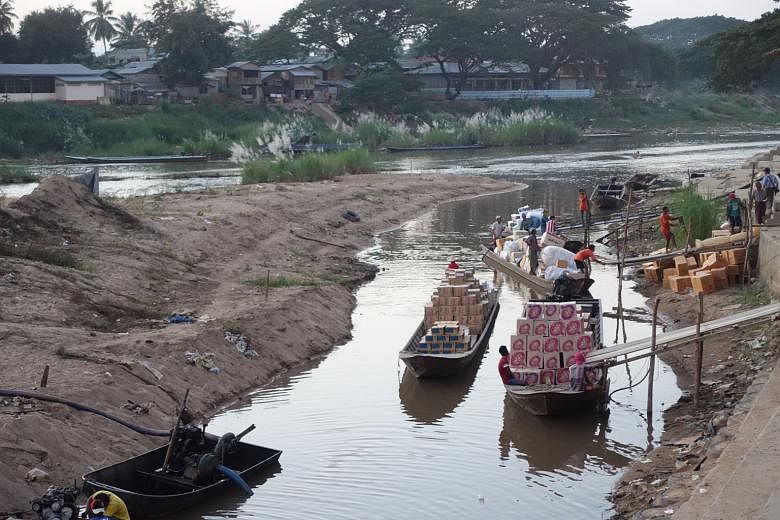BANGKOK • In a decade's time, visitors to Asean, South and North Asia may find their personal experiences in their respective destinations differ quite drastically.
Each Asian nation is busy operating at its own pace, plotting a new stage of economic development and growth - despite ongoing global economic uncertainty.
In the process of this seismic shift, some countries have chosen to work in partnerships while others are tackling the challenges alone. All of them reflect Asia's unique aspiration to take on global competitive pressure. Some nations aim to get out of the middle-income trap, while others want to secure a higher standard of living for their people.
In Asean, leading the pack are Malaysia and Singapore - the dual trackers - with the much-heralded high-speed train project linking Kuala Lumpur and Singapore, at an estimated cost of US$17 billion (S$23 billion). Once completed, train travel between these two destinations will take just 90 minutes.
This will deepen links between the two high-income Asean members and expand scalability, especially for Singapore, with its limited land and manpower. It could well be that Kuala Lumpur will join Singapore as another world-class city to work in and ease the latter's vulnerability to being priced out as the world's most expensive location.
The other two Asean dual trackers are Thailand and Myanmar. Although more humble, there are plans to bring the 120-million population market closer together. One day, they may even form a single market!

Under way is the construction of special economic zones along the border between the two countries. This would facilitate freer flows of workers, businesses and communications. It would merge the border areas' sub-economic zones, such as Mae Sot in Thailand's Tak province and the Myanmar city of Mawlamyine.
During the decades that Myanmar was shut off from the world, the area was arguably, aside from Yangon, the most high-income generating part of the country, revealing the benefits of being adjacent to a complementary higher-income country.
On a grander scale, some economic sector mergers between Thailand and Myanmar could be a game changer to help fast-forward the development and income of the latter. Together, they have scalability, complementary economies and strategic geography. And let us not forget the Dawei Special Economic Zone farther south, which both countries are determined to make work despite the odds.
Of the other sizeable Asean member nations, Indonesia, the Philippines and Vietnam are on a single track but in equally dynamic mode, with most efforts being spent on "putting the house in order".
There is not a day that goes by when Indonesian President Joko "Jokowi" Widodo does not try to energise the bureaucracy, government policies and private investments. With a population of 200 million, Indonesia is a huge market. We cannot say that Jokowi is not doing his best to put Indonesia back where it belongs. He has repeatedly called on his government coalition partners to back him.
Likewise, new Philippine President Rodrigo Duterte wants to carry on where his predecessor left off in ending the impact of the last couple of decades following the Marcos era, especially in raising business confidence and pursuing massive infrastructure investments that will link Manila with other cities and reduce income disparities.
Vietnam presents an interesting forward-looking approach as a single tracker. As a state-led economy, the country's stakeholders are able to move as a pack and can fire on all cylinders. This freedom affects everything from regulatory reforms and business sector liberalisation to infrastructure investment, tourism and outward investment. In Asia, the country is now the darling of investors. Vietnam is making its regional presence felt, along with Laos, Cambodia and Myanmar.
Cambodia has leaned heavily on China for its economic advancement, which is also the result of economic liberalisation. Many businesses there can be 100 per cent foreign-owned. Phnom Penh is full of foreign bank branches enjoying minimal capital and regulatory requirements. Prime Minister Hun Sen's approach appears to acknowledge that the "loss of some sovereignty" is outweighed by the economic benefits that can be derived from such a loss. He would argue that Asean unity is less important in delivering wealth to his country than Cambodia's tango with China.
South Asia's economic future is still shaped by India. The Modi government is determined to wrest control and realign fragmented Indian economic regulations in different states under a unified directive from Delhi. India will also see innovation from the long-tail technology business. Aviation reform and infrastructure spending are gathering pace. Real advancement will become more visible if Prime Minister Narendra Modi wins a second term in office.

Not to be outdone is Pakistan, with support from China's One Belt One Road initiative, which provides a port and highway to the Arabian Sea. The Pakistani army is mulling over speeding up the work based on its engineering skills. Anything that can bring peace and tame terrorism would be a boon to the country. The same could be said of Bangladesh, as the fast-moving garment and textile supply-chain hub of the world.
North Asia, meanwhile, is undergoing more of a reinvention on a global scale. The location plays appear outdated as Japan, for instance, has found its old "chequebook diplomacy" to be less effective in the modern era. Japan now pins its hopes on innovation in robotics, medicine, biotechnology and renewable energy. The reinvention timeline will coincide with Japan's hosting of the 2020 Olympics. Nonetheless, the Abe government has found the globalisation of Japan an ongoing challenge.
South Korea has come on strong with its determination to build wealth around cultural exports. South Korean embassies around the world place cultural diplomacy above all else in their external engagements. The Korean conglomerates have also started early on the "Internet of Things" to stay ahead in the global consumer electronics market.
Likewise, Taiwan is working on its niche competitiveness, focusing on its outstanding skills in machinery and mechanisation. It never loses sight of any opportunity to own or create a global brand, as seen with the takeover of Sharp Corp.
China stands unique as a multi-tracker targeting rail networks and other infrastructure investments, the One Belt One Road initiative, e-commerce and financial technology, overseas takeovers, outward tourism and long-tail businesses that can ride the threat of a deflationary economy.
In many ways, China's foreign policy has propelled many strategic changes among Asian nations - alongside the forces of technology and global consumerism.
When Chinese Premier Li Keqiang told editors of Asia News Network in Beijing that China's status is still that of a developing country and not a mighty economic superpower, he was quite right. But together with its state-led strategy, nationalistic ideals, embedded 5,000 years of history and huge business-minded population, China's economic thrust is fuelled by its prowess and evokes awe from onlookers.
- The writer is executive director of Asia News Network, an alliance of 21 leading media in 19 Asian countries. The Asian Editors Circle is a series of columns on global affairs written by top editors from members of the ANN and published in newspapers across the region.


